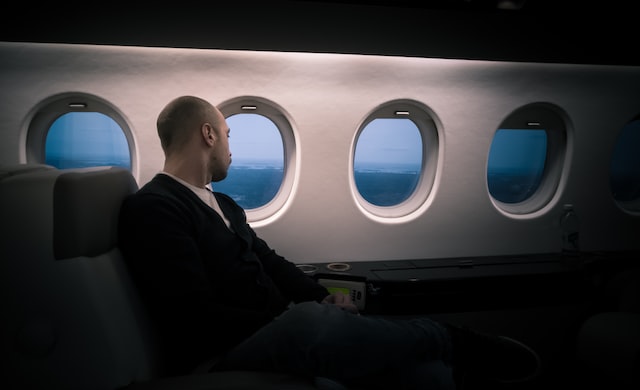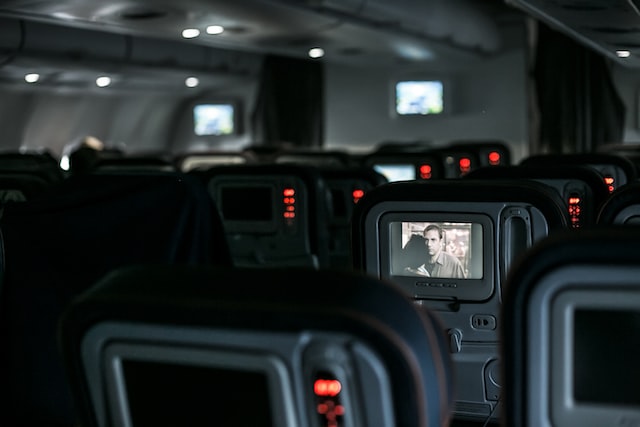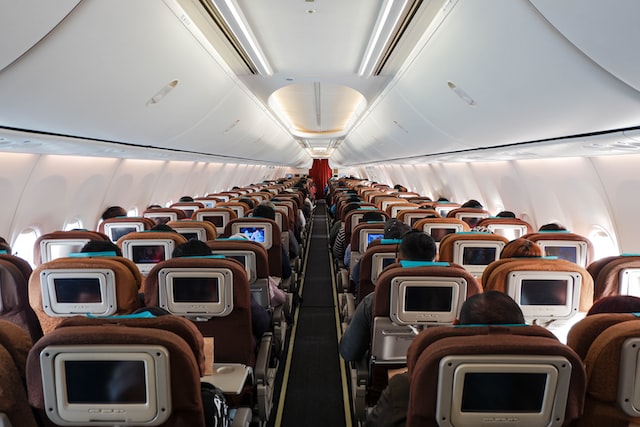When it comes to air travel, there are three main classes: first class, business class, and economy class. First class and business class are both considered to be premium travel experiences. Flying first class or business class is a fantastic way to travel with all of the amenities that come with it. The biggest difference between the two lies in the amount and type of services that are offered on board. Flying first class comes at a premium cost due to its superior level of service, wider seats and more luxurious dining options compared to business class. Ultimately, the decision will depend on personal preference and budget.
The difference between flying first class and business class?
(Photo by Joakim Honkasalo on Unsplash )

When it comes to flying, there are generally three different types of classes: first class, business class, and economy class. First class and business class are considered the higher classes, while economy is the lower class. There are a few key differences between flying first class and business class.
First and foremost, flying first class is significantly more expensive than flying business class. This is because first-class passengers receive a number of additional amenities and privileges that business-class passengers do not. For example, first-class passengers typically have access to private lounges at airports, they are served gourmet meals on board, and they are given larger seats with more legroom and privacy.
Another key difference between flying first class and business class is the level of service that passengers receive. First-class passengers are given priority over other passengers when it comes to boarding the plane, they are served by a dedicated team of flight attendants, and they typically have access to a concierge service that can help with things like making restaurant reservations or booking hotel rooms. Business-class passengers usually don’t receive this same level of service.
Finally, another difference between flying first class and business class is the type of aircraft that passengers fly on. First-class passengers typically fly on larger aircraft with more luxurious interiors, while business-class passengers usually fly on smaller aircraft with less luxurious interiors.
The difference in seats
Seat size: First Class seats are usually larger and more spacious than Business Class seats, with more legroom and wider seats. Some First Class seats may also have a privacy partition for added comfort.
Seat type: First Class seats may be fully lie-flat beds, while Business Class seats may have a limited recline or a cradle-style recline.
The difference in food
Menu selection: First Class passengers often have a more extensive menu selection than Business Class passengers, with a wider range of options and higher quality ingredients.
Presentation: Meals in First Class are typically presented on fine china with silverware, and may include multiple courses. In Business Class, meals may be served on plastic or ceramic plates with plastic utensils.
Service: First Class passengers may receive a more personalized dining experience, with dedicated flight attendants and the option to dine whenever they choose. Business Class passengers may have set meal times and may share a dining area with other passengers.
Quality: The quality of the food and beverage offerings in First Class is often higher than in Business Class, with premium wines and spirits, higher quality ingredients, and gourmet options.
Special requests: First Class passengers may have the option to make special requests for their meals, such as vegetarian, gluten-free, or kosher options. Business Class passengers may also have special meal options available, but they may not be as extensive as those in First Class.
The difference in service
Personalized attention: First Class passengers usually receive more personalized attention from flight attendants, with dedicated service and higher staff-to-passenger ratios. Business Class passengers also receive good service, but it may not be as personalized or as extensive as that offered in First Class.
Priority services: First Class passengers often have access to priority check-in, security, and boarding, which can save time and provide a more seamless travel experience. Business Class passengers may also have access to priority services, but they may not be as comprehensive as those offered in First Class.
In-flight amenities: First Class passengers have access to a wider range of amenities, such as lie-flat beds, high-quality bedding and pillows, noise-cancelling headphones, and luxury amenity kits. Business Class passengers also receive many of these amenities, but they may not be as high-end or extensive as those in First Class.
Dining options: First Class passengers usually have access to a wider range of high-quality dining options, with personalized service and the ability to dine whenever they choose. Business Class passengers also receive good dining options, but they may have set meal times and may share a dining area with other passengers.
Lounge access: First Class passengers usually have access to exclusive airline lounges, which offer a more comfortable and relaxing pre-flight experience. Business Class passengers may also have access to lounges, but they may not be as exclusive or as comprehensive as those offered in First Class.
The difference space
Cabin configuration: First Class cabins usually have fewer seats than Business Class cabins, which provides more space and a quieter and more exclusive environment. Business Class cabins may have a larger number of seats, which can make the cabin feel more crowded.
Amenities: First Class passengers have access to a wider range of amenities, such as larger in-flight entertainment screens, high-quality bedding and pillows, noise-cancelling headphones, and luxury amenity kits. Business Class passengers also receive many of these amenities, but they may not be as high-end or extensive as those in First Class.
Storage space: First Class seats often have more storage space for personal items, such as larger overhead bins, compartments for hand luggage, and personal storage areas. Business Class seats may also have storage space, but it may not be as extensive as in First Class.
The difference in cost
(Photo by Alev Takil on Unsplash )

The cost difference between First Class and Business Class can vary significantly depending on the airline, flight route, time of booking, and other factors. Generally, First Class is significantly more expensive than Business Class, sometimes costing several times more. However, the exact cost difference varies widely depending on the specific flight.
One factor that can contribute to the cost difference is the level of luxury and exclusivity provided in First Class. First Class passengers receive a more personalized and luxurious travel experience, with larger seats, better amenities, and more attentive service. This level of luxury comes at a premium price.
Another factor that can affect the cost difference is the availability of award seats and upgrades. Airlines may offer upgrades from Business Class to First Class for a fee or through a loyalty program, but these upgrades may be limited in availability and may come at a high cost.
In general, First Class is a premium product that caters to the highest-end of the market, and it is priced accordingly. Business Class provides a more comfortable and enjoyable travel experience than Economy Class, but it is generally more affordable than First Class.
What is economy class?
Whether you’re flying for business or pleasure, there’s a good chance you’ll end up in economy class. Economy class is the most basic and economical way to fly, and it’s generally the cheapest option when booking a flight.
So what exactly is economy class? Economy class flights typically have 3-4-3 seating arrangements (three seats on each side of the aisle, with four in the middle), which means that there are more seats in economy than any other cabin class. This can make it feel cramped and uncomfortable, especially on long flights.
The seats in economy are also narrower than those in first or business class, and they don’t recline as much. Some airlines have started to offer “premium economy” which is a step up from regular economy – the seats are wider and have more legroom, and the food and service is usually better as well. But premium economy can still be quite cramped, so it may not be worth the extra cost for some travelers.
The disadvantages of flying first class over economy class
While there are many advantages to flying First Class over Economy Class, there are also some disadvantages to consider:
- Cost: First Class tickets are significantly more expensive than Economy Class tickets, sometimes costing several times more. This can make it difficult for many travelers to justify the cost, especially for shorter flights.
- Limited availability: First Class seats are limited in availability, and may sell out quickly or be reserved for frequent flyers or other high-end customers. This can make it difficult to book a First Class ticket, even if you are willing to pay the high price.
- Less frequent flights: Airlines often offer fewer First Class flights than Economy Class flights, which can limit your options for travel. This may make it difficult to find a convenient flight time or route that fits your needs.
- Less flexibility: First Class tickets often come with more restrictions than Economy Class tickets, such as more limited change and cancellation policies. This can make it more difficult to change your travel plans if something unexpected comes up.
- Reduced social interaction: While the privacy and exclusivity of a First Class cabin can be a positive feature for some travelers, it can also limit social interaction and the opportunity to meet new people on the flight.
- Environmental impact: First Class seats take up more space and resources than Economy Class seats, which can contribute to a higher carbon footprint per passenger. This can be a concern for travelers who are mindful of their environmental impact.
Overall, while First Class provides a more luxurious and comfortable travel experience, it is also more expensive and may have more restrictions than Economy Class. It is important to weigh the advantages and disadvantages of each class of travel to determine which option is the best fit for your needs and budget.
Featured Image By – Photo by Mohammad Arrahmanur on Unsplash








